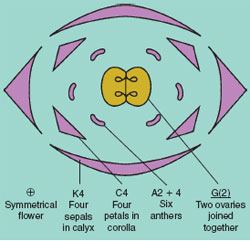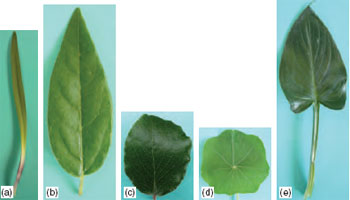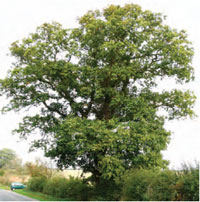Content
Plants can be grouped into other useful categories. A classification based
on their lifecycle (ephemerals, annuals, biennials and perennials) has
long been used by growers, who also distinguish between the different
woody plants such as trees and shrubs. Growers distinguish between
those plants that are able to withstand a frost (hardy) and those that
cannot (tender); plants can be grouped according to their degree of
hardiness. Table 4.4 brings together these useful terms, provides some
definitions and gives some plant examples.
Identifying plants
 |
| Figure 4.6 Floral diagram of wallflower |
A flora is a text written for the identification of flowering plant species.
Some flora use only pictures to classify plants. More detailed texts
use a more systematic approach where reference is made to a key of
features that, by elimination, will lead to the name of a plant. Species
are described in terms of their flowers, inflorescences, stems, leaves and
fruit. This description will often include details of shape, size and colour
of these plant parts. Flowers: The number and arrangement of flower parts (see Figure 4.6)
is the most important feature for classification and is a primary feature
in plant identification. It can be described in shorthand using a floral
formula or a floral diagram. For example, the flora formula, with the
interpretation, for Wallflower ( Cheiranthus cheiri), a member of the
Cruciferae family is as follows:
⊕
symmetrical
flower |
K4
4 sepals
in calyx |
C4
4 petals in
corolla |
A2 + 4
6 anthers |
G(2)
2 ovaries joined
together |
Other examples of floral formulae include:
Sweet pea
(Fabaceae): |
./. |
K(5) |
C5A(9) + 1 |
G1 |
Buttercup
(Ranunculaceae): |
⊕ |
K |
C5A |
G |
Dead nettle
(Labiatae): |
./. |
K(5) |
C(5)A4 |
G(2) |
Daisy
(Asteraceae): |
⊕ |
K |
C(5)A(5) |
G(2) |
 |
| Figure 4.7 Wallflower flower (a) from above, (b) the side and (c) LS, illustrating the floral diagram above |
 |
Figure 4.8 Leaf forms : (a) linear e.g. Agapanths; (b)
lanceolate e.g. Viburnum; (c) oval e.g. Garrya elliptica;
(d) peltate e.g. nasturtium; (e) hastate e.g. Zantedeschi ;
(f) lobed e.g. Geranium; (g) palmate e.g. lupin; (h) pinnate
e.g. rose |
The way that flowers are arranged on the plant is also distinctive in
different families, e.g. raceme, common in the Fabaceae; corymb and
capitulum found in the Asteraceae and umbel, very much associated
with Apiaceae.
Leaf form (see Figure 4.8) is a useful indicator when attempting to
identify a plant and descriptions often include specific terms, a few are
described below but many more are used in flora.
- Simple leaves have a continuous leaf blade, for example: linear,
lanceolate, ovate, obovate, orbicular, oval.
- Margins of leaves can be described: entire, sinuous, serrate, and
crenate.
- Leaf vein arrangement also characterizes the plant: reticulate,
parallel, pinnate and palmate.
- Compound leaves, such as compound palmate and compound
pinnate, have separate leaflets each with an individual base on one leaf
stalk, but only the axillary bud is at the
base of the main leaf stalk.
Most horticulturists yearn for stability in the naming of plants. Changes
in names confuse many people who do not have access to up-to-date
literature. On the other hand, the reasons for change are justifiable. New
scientific findings may have shown that a genus or species belongs in
a different section of a plant family, and that a new name is the correct
way of acknowledging this fact. Alternatively, a plant introduced from
abroad, maybe many years ago, may have mistakenly been given the
incorrect name, along with all the cultivars derived from it.
Evidence from biochemistry, microscopy and DNA analysis is proving
increasingly important in adding to the more conventional plant
structural evidence for plant naming. There may be differing views
whether a genus or species should be 'split' into smaller units, or several
species be 'lumped' into an existing species or genus, or left unchanged.
It seems likely that changes in plant names will continue to be a fact of
horticultural life.
There has been a massive increase in communication across the world,
especially as a result of the Internet. The level of information about plant
names has improved. The International Code of Botanical Nomenclature
(ICBN) has laid down an international system. Within Britain, the
Royal Horticultural Society (RHS) has an advisory panel to help
resolve problems in this area. An invaluable reference document 'Index
Kewensis' is maintained by Kew Gardens listing the first publication
of the name for each plant species not having specific horticultural
importance. Cultivated species are listed in the 'RHS Plant Finder',
which also indicates where they can be sourced, is updated annually
and can be viewed on the Internet. Further cooperation across Europe
has led to the compilation of The International Plant Names Index with
associated working parties formed from scientific institutions and the
horticultural industry.
Geographical origins of plants
Gardens and horticultural units, from the tropics to more temperate
climates, contain an astonishing variety of plant species from the
different continents. Below is a brief selection of well-known plants,
grown in Britain, illustrating this diversity of origin. It is salutary,
when considering these far-flung places, to reflect on the sophisticated
cultures, with skills in plant breeding and a passion for horticulture over
the centuries that have taken wild plants and transformed them into the
wonders that we now see in our gardens.
 |
Figure 4.9 Oak Tree
(Quercus robur) – a native of
the British Isles |
- British Isles; English Oak (Quercus robur), Geranium robertianum, foxglove, peppermint,
Pinus sylvestris.
- Far East (China and Japan); cherry, cucumber,
peach, walnut, Clematis, Forsythia, hollyhock,
Azalea, rose.
- India and South-East Asia; mustard, radish.
- Australasia; Acacia, Helichrysum, Hebe.
- Africa; Phaseolus, pea, African violet, Strelitzia,
Freesia, Gladiolus, Impatiens, Pelargonium,
Plumbago.
- Mediterranean; asparagus, celery, lettuce,
onion, parsnip, rhubarb, carnation, hyacinth, Antirrhinum, sweet pea, Rosemarinus officinalis.
- Middle East and Central Asia; apple, carrot,
garlic, grape, leek, pear, spinach.
- Northern Europe; cabbage, Campanula, Crocus,
forget-me-not, foxglove, pansy, Primula, rose,
wallflower, parsley.
- North America; Aquilegia, Ceonothus, lupin,
Aster, Penstemon, Phlox, sunflower.
- Central and South America; capsicum, maize,
potato, tomato, Fuchsia, nasturtium, Petunia, Verbena.
|









